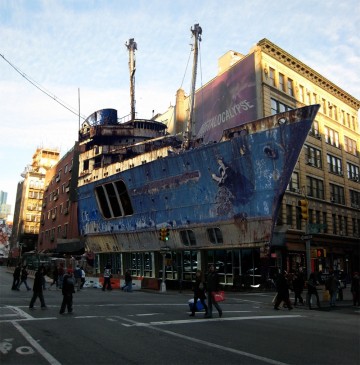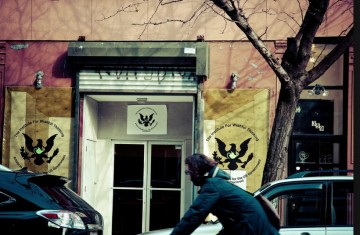
Exterior view: Institute for Wishful Thinking Artists in Residence for the US Government at Momenta, April, 2011. Photo: Bianca Prime.
In the past decade the visual arts have seen a retreat from traditional locations of meaning making and power. This retreat can be partially attributed to the increasing disparity between artists with professional training (BAs, MFAs, various forms of apprenticeship), and those who are able to make a living through their work, let alone become “stars.” This exodus, to use a term of the Italian critical theorist Paolo Virno, has taken shape as a mass movement under the radar of official art history, art institutions, and art “world” marketplaces, and yet as a response to the aporia these very histories, institutions, and economies present us with.
The trajectory of Maureen Connor’s work, which moves from investigations of feminism and the critique of (institutional) spaces in the 70s and 80s and 90s towards service and labor-related investigations in the late 90s and 2000s, parallels a recent trajectory among visual artists, some of whom have been covered by this column. In this trajectory, artists have become increasingly interested in service (what Cuban-American artist Tania Bruguera calls “useful art”) and “mock institutions” (Gregory Sholette’s term for organizations that appropriate corporate and governmental bureaucracy).
Connor’s recent work departs from projects like Personnel, which attempts to critique labor conditions in post-Fordist work places while also attempting to make those environments more livable for those who must inhabit them. See for instance her project, Fresh Windows, in which the artist points to the dystopian aspects of a windowless office culture, while offering the best possible solution to this problem—barring the creation of windows themselves (curtains and video monitors merely depict life outdoors). One may also check out Connor’s project for an office in Gdansk, Poland, in which she preserves vestiges of the previous post-industrial space by printing a photograph of the space on curtains. In her renovation she uses casts of toilets for seating, which she says she hopes will maintain a sense of humor in the work environment.
In the works of Personnel Connor explores a tension between the work environment as a kind of ruin—a place inhabited by future’s past—and as a site begging for revivification, to which one can give new life while not abandoning its history. Working with limited means, Connor has been resourceful in exploring these problems, which anticipate her most extensive project to date. The Institute for Wishful Thinking, which she founded with Gregory Sholette and others in 2008 and discusses below, moves beyond the criticism and practical design problems of her former projects into problems of legal and non-governmental mediation. Soliciting proposals from individuals, and making possible residencies for artists and art groups, IWT attempts to mediate between governmental and non-governmental sectors on behalf of artists who believe their work can benefit the public good.
Comparing IWT with other mock institutions, what seems unique about the organization/art group is its eagerness to affect the ways that governmental and non-governmental organizations intersect to promote social justice and change. Whereas many mock institutions end at the impersonation of governmental and corporate institutions through their name or superficial aspects of their appearance, IWT seeks to exploit policy channels in order to make it possible for artists of all sorts to have more of a say in public decision-making.
As IWT puts up proposals by supported artists at their website, I am excited to see which if any will catch hold. Such as Sheryl Oring’s, who “[a]s Secretary of the People, […] would […] create means of communication with the population at large, and then represent the people’s key concerns –- as well as possible solutions to national problems — to the President and others in the Cabinet;” or Christopher Robbins’s, who plans to “link the Department of Housing and Urban Development with community members, artists, and homeless advocates to turn abandoned property into shelters for the homeless in a quick, direct, D.I.Y. style – people making their own homes in abandoned structures with Government support.”
Regardless of whether any of the proposals IWT eventually receive funding/support from the government, the group has produced an integral model for how artists might situate themselves between governmental and non-governmental agencies. With projects like Connor’s IWT, the myth of artistic autonomy dissipates, leveling the roles of citizen and artist, governmental institution and artists organized around a particular cause they are willing to put their efforts towards.
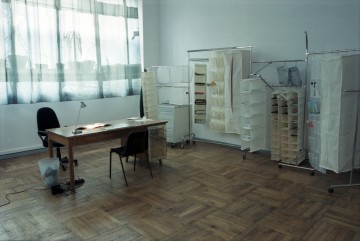
Personnel 4, 2004-7. Office for Aneta Szylak, Director, Wyspa Art Institute, Gdansk, Poland, located in the historic Gdansk shipyard, originally commissioned for the exhibition "Health & Safety." Photo: Marek Frankowski.
1. What is your background as an artist and how does this background inform and motivate your practice?
Born as the first child of the baby boom generation into a huge Irish Catholic family in Baltimore, I was aware very early of a pressure to achieve, as well as the immense challenge of navigating through a complicated labyrinth of restrictions and limits. Many years of all-female Catholic education brought both intellectual support and extreme repression. Yet that same education somehow enabled me to recognize the hypocrisy and arbitrary nature of the authority behind many of those imposed restrictions. I ended up with a profound skepticism and a habit, perhaps even a compulsion, to constantly question authority.
When I arrived in New York my timing was fortuitous. The late 60s was a moment of relative openness and experimentation. There was a culture that encouraged everyone to question the boundaries of officially sanctioned art. It was even possible to point out that this official canon seemed especially arbitrary when it came to the way women’s work was evaluated and received. So that freedom to question the powers that be at my moment of entry into the art community paralleled my own compulsive questioning. I saw myself as part of an environment that would always welcome and reward direct challenges. My fondness for wishful thinking, which takes center stage in a recent project, The Institute for Wishful Thinking, perhaps started then.
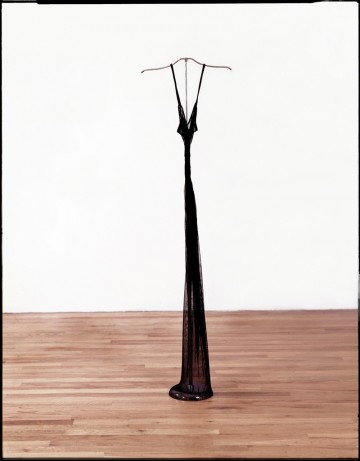
"Thinner Than You," 1990. Stretch net over stainless steel dress rack, 60” X 16” x 8." Photo: Thaddeus Govan.
From the early 70s until the late 90s I was committed to an overt feminist exploration of how gender is represented in the everyday objects and imagery that surround us. I still consider my work feminist in its ability to unpack the cultural determinants embedded within everyday objects and situations, however my current focus is not primarily on gender. At the end of 1999, in response to a commission for a survey show, I took a different direction, beginning an exploration of an art institution’s workforce in relation to its social, political, economic, and aesthetic make up. As the opening date for the survey show approached, one participating institution was embroiled in an employee crisis that made continued planning almost impossible. So I tried an experiment: I offered a large portion of my exhibition space to create an environment for the staff to use. To encourage dialogue about my experiment, I interviewed each of the institution’s fifty-two employees. Although I did not expect their conditions to be significantly altered by my installation, the process and the resulting work did direct attention to the employees’ problems providing solutions that were mostly symbolic. This was the first of a series of installations titled Personnel, now a continuing investigation of art institutions as workplace.
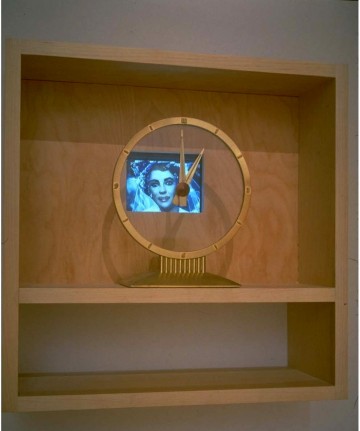
"Time Matters," 1999-2000. Clock, shelf, video of images of classic movie stars morphing from youngest to oldest versions of themselves in movies.
[vimeo:https://vimeo.com/22966669]
2. Do you feel there is a need for the work that you are doing given the larger field of visual art and the ways that aesthetic practices may be able to shape public space, civic responsibility, and political action? Why or why not?
While I’ve always looked at the social function of art, both past and present, I’ve been actively exploring work that has direct social impacts since that first Personnel project. Although it was largely a failure in terms of making a difference in the work lives of the staff, I began to think that the model of embedding artists in organizations in order to question its values and reframe its conditions could actually produce change. One of the intentions of Personnel is to call attention to and empower those who usually remain invisible, the museum staff who do much of the behind-the-scenes work to produce exhibitions. At the same time most art institutions are elite communities that offer cultural capital to their staff in lieu of living wages, so I began to wonder if change was possible in this context. Seeking to embed artists in situations with more at stake than challenging art world hierarchies, I made contact with several NGOs and also considered how to approach government agencies and offices.
In 2008 I had the opportunity to develop a collective, the Institute for Wishful Thinking, with my colleague at Queens College, Gregory Sholette, and a group of our then graduate students who are now all accomplished artists in their own right.

"Fresh Windows," 2009. 2 Proposals for the CRDP Workroom, Montreal. https://www.maureenconnor.net/projects-CRDPfreshwindows.htm.
The Institute for Wishful Thinking, which in some ways grew out of Personnel, was a collaborative group founded to grant wishes that offer both practical assistance and possibilities for change. IWT’s research has shown that a request for wishes allows an organization the opportunity to fantasize about its potential while also addressing its needs. Since the IWT works with organizations, not individuals, wishes are usually directed toward a specific organizational challenge. Originally formed for the exhibition “Art as Gift” (the theme of the Periferic 8, Biennial of Contemporary Art, Iasi, Romainia), IWT then produced a project for a Critical Management Studies (CMS) conference.
Based upon a consensus in CMS that more creative thinking was needed to implement change, we proposed that the scholars presenting papers at the 2009 CMS conference devise solutions to the problems outlined in their papers, asking them to envision their solutions as wishes.
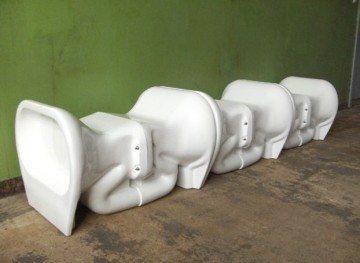
"Personnel 4," 2004-7 (detail), ‘toilet seats’ for the Wyspa Art Institute, Gdansk, Poland, located in the historic Gdansk shipyard, was originally commissioned for the exhibition "Health & Safety."
Later that year the IWT made a proposal for the renovation of a building called the Peace Pentagon. Located at the corner of Lafayette and Bleecker in Manhattan, the Peace Pentagon has been headquarters for dozens of progressive activist organizations for 40 years. Now in need of major repairs, a call for proposals was issued which asked the question: how can a building mobilize for peace and justice? We answered that challenge by presenting a proposal for the Peace Pentagon that also addressed the problem of ship breaking, an industry that represents one of the darkest corners of globalization.
Because outsourcing of production to China, India and other Southeast Asian locations has produced an increased need for ships, vessels that are barely seaworthy are frequently reconfigured to transport goods and materials between Asia and the west. And when they are on the verge of disintegration their final journey lands them on the beaches of Bangladesh, India, or Pakistan where they are taken apart by unskilled laborers, often children who risk disability or even death because of unsafe working conditions.
When Professor George Cairns of RMIT University, Melbourne, Australia presented a paper on ship breaking at the 2009 CMS conference, one of his solutions/wishes was to “sail a redundant supertanker, bulk carrier, warship or ferry up the river of every major city of the ‘developed world’—a ship that has been owned and exploited by one of its citizens, agents or companies—sink it in full public view and challenge each local government to address the problem.”
IWT took Professor Cairns’ wish one step further by repurposing an obsolete ocean liner, rescued from the ship breaking industry to serve as the Peace Pentagon’s new headquarters. Essential to the proposal was the mandate that Bangladesh laborers be brought to New York and paid union wages to restore and repurpose the ship. During the ship renovation process they would be taught necessary skills and safe construction practices by out-of-work shipbuilders from defunct American shipyards.
In the current IWT project, Artists in Residence for the US Government (self- declared), we take a slightly different tack than in the past: we have imagined our own wishes in order to affect the most pressing social problems. Our means of wish-fulfillment places artists in residence within government agencies and departments.
IWT begins with the belief that artists can make substantial contributions to reframing and contributing to the solutions for a broad range of social issues and concerns. Through this call for proposals we also hope to provide a forum that will increase understanding of what artists do and how they contribute to society and encourage the public to think about them as potential collaborators in a variety of circumstances. Ultimately, we aim to show that artists have boundless potential to serve as creative consultants to public policymakers, community leaders, and elected officials. Our website provides information about how social policy is made and creates links to a broad range of government organizations.
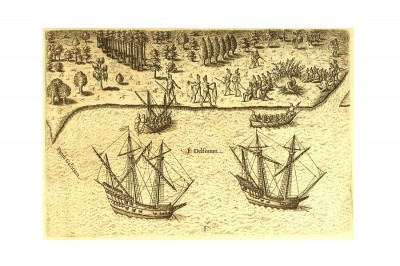
Contaminating the Preserve, a proposal by Ryan Griffis to preserve community and ecological health https://theiwt.com/proposals/artist-ryan-griffis/.
3. Are there other projects, people, and/or things that have inspired your work? Please describe.
Although unknown to me when I began the Personnel project, the Artists Placement Group, a collective formed in the UK in the late 60s by Barbara Steveni and John Latham, was among the first to explore the concept of the “embedded” artist. Their original idea was “to expand the reach of art and artists into commercial/industrial concerns, government agencies and organizations of all kinds, at all levels, including decision-making, on a basis equivalent to any other engaged specialist.” If artists’ ideas and approaches are not included in the everyday functioning of governments, organizations and institutions, then the body politic is deprived of a valuable perspective. The Tate Gallery purchased the APG archive in 2004.
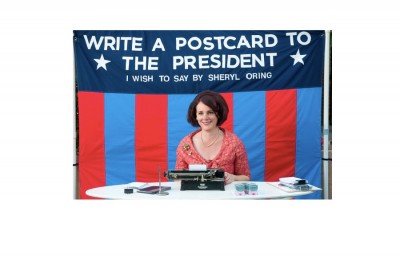
I Wish to Say, a Proposal by Sheryl Oring to the Institute for Wishful Thinking Artist in Residence for the US Government (self declared) for a new cabinet position: Secretary of the People. https://www.iwishtosay.org/index.php.
4. What have been your favorite projects to work on and why?
The current Institute for Wishful Thinking project, Artists in Residence for the US Government (self declared), continues to be my favorite project. In April-May 2011 we used Momenta Art in Brooklyn as our project headquarters. During that time, in addition to having public events and workshops, many non-art neighborhood people came in to ask what we were doing and most were very open about their frustrations with the government and seemed willing to consider the alternative approaches to change we were proposing. That process of welcoming hesitant visitors to the space, explaining the project, and engaging them in discussions helped me realize that our project might not be so radical or such a hard sell after all.
5. What projects would you like to work on in the future? What directions do you imagine taking your work in?
I plan to continue with the IWT’s AIR project. Recently Rocco Landesman, current Chair of the NEA, spoke at a Ford Foundation conference about his idea to approach other better-funded government agencies like Health and Human Services and the Department of Agriculture to partner with the NEA. This idea seemed quite visionary and maybe not that far away from the IWT AIR.
While it may just be my own wishful thinking, I imagine placing artists in residence in the House and Senate, the White House, the Justice Department and every other agency from DARPA to the IRS.
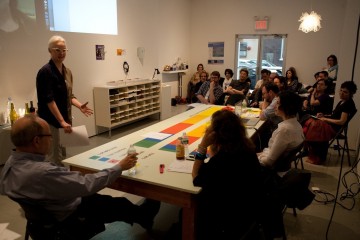
Panel Discussion Modeling Alternatives: A Discussion Part 2; Directors of innovative institutions both small and large discuss alternative models of collaboration. Organized by the Institute for Wishful Thinking: Artists in Residence for the US Government (self declared) at Momenta Art, May 7, 2011. Photo: Tommy Mintz.

